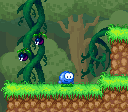People are saying you need some wavey-type-action for your wings.
Take
a piece of paper, right now, and "flap" it downward. The part of the
paper that you're actively gripping will get pushed the furthest, and
every other bit of the paper will follow the action of where you're
gripping. The further the distance from the origin of force (grip
point), the "slower" it will trail the main force.
The same goes
for a bat (or ball)'s wing's. When a bat flaps its wings, most of the
force is applied through the shoulder (or seems to be! I could be
mistaken

) and as such, the bits of the wing furthest from the origin of force
(in this case the shoulder) will move down at a slower rate, and thus
appear to be higher.
In doing this, things form "C-curves" that instantly tell us where the force is, how much force there is, and where it is going.
The
biggest problem with your ball, at the moment, is that its wings are
always in a C-curve that suggests they're moving UP, and never acheive a
C-curve that suggests they're moving DOWN. Confused?
C <---- that would be a C-curve suggesting force being applied leftwardly
) <---- that would be a C-curve suggesting force being applied toward the right.
The
top curve is suggesting more force is being applied to it than the
bottom curve, because of its more extreme... curve. There aren't up and
down brackets, far as I know, so I hope that's clear enough! Your wing's
C-curves are always suggesting UPWARD motion, and you need to imply
DOWNWARD force in order to show that the body of the beast is being held
UP by this DOWNWARD pressure. IF the only pressure ever seen is UPWARD,
it'll sooner be seen as flying/swimming downward, rather than flying
upward.
If that's not enough, I suggest you do some researchy
bits on "Anticipation, Action, and Reaction" and "overlapping action /
wave action" for a couple core things on animation and animating.

